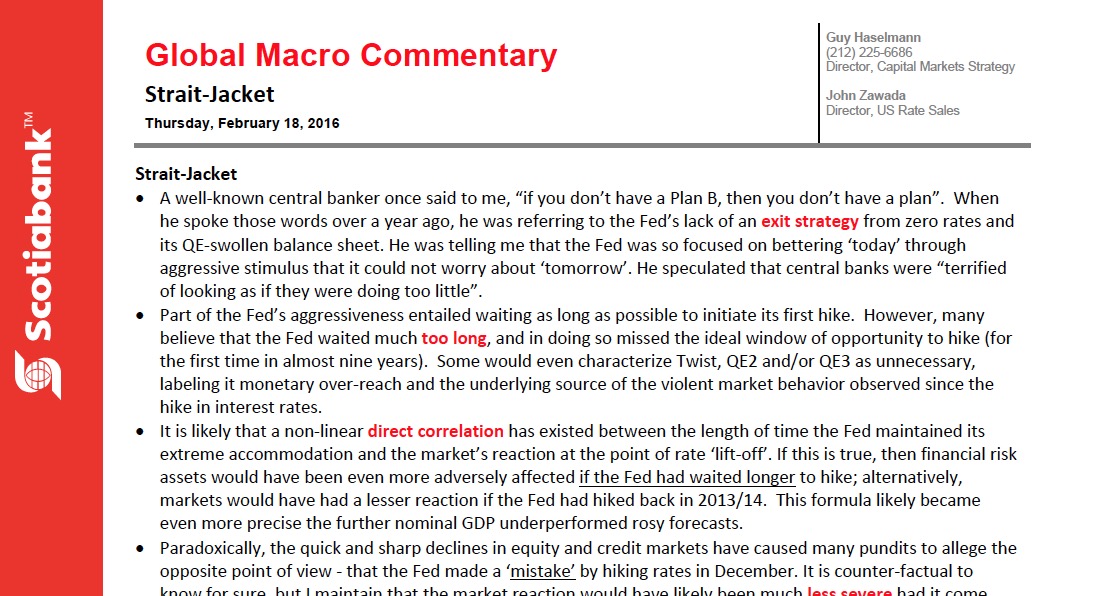Strait-Jacket
by Guy Haselmann, Director, Capital Markets Strategy, Scotiabank GBM
· A well-known central banker once said to me, “if you don’t have a Plan B, then you don’t have a plan”. When he spoke those words over a year ago, he was referring to the Fed’s lack of an exit strategy from zero rates and its QE-swollen balance sheet. He was telling me that the Fed was so focused on bettering ‘today’ through aggressive stimulus that it could not worry about ‘tomorrow’. He speculated that central banks were “terrified of looking as if they were doing too little”.
· Part of the Fed’s aggressiveness entailed waiting as long as possible to initiate its first hike. However, many believe that the Fed waited much too long, and in doing so missed the ideal window of opportunity to hike (for the first time in almost nine years). Some would even characterize Twist, QE2 and/or QE3 as unnecessary, labeling it monetary over-reach and the underlying source of the violent market behavior observed since the hike in interest rates.
· It is likely that a non-linear direct correlation has existed between the length of time the Fed maintained its extreme accommodation and the market’s reaction at the point of rate ‘lift-off’. If this is true, then financial risk assets would have been even more adversely affected if the Fed had waited longer to hike; alternatively, markets would have had a lesser reaction if the Fed had hiked back in 2013/14. This formula likely became even more precise the further nominal GDP underperformed rosy forecasts.
· Paradoxically, the quick and sharp declines in equity and credit markets have caused many pundits to allege the opposite point of view - that the Fed made a ‘mistake’ by hiking rates in December. It is counter-factual to know for sure, but I maintain that the market reaction would have likely been much less severe had it come earlier, and much more severe had the Fed delayed the inevitable even further. Therefore, if there was a ‘mistake’, it was hiking too late, rather than hiking in December. There is never a “good time” to hike rates (reduction ad absurdum)
· It is easy to play ‘armchair quarterback’, but few would disagree that ‘good’ policy leads to good outcomes. By waiting so long to shift gears, debt levels increased further, global and US economic growth waned, China and Japan stumbled, and geo-political tensions increased. One thing seems clear, the Fed’s timing became ‘less good’.
· Some of you may be thinking that the factors just listed would suggest that no hikes would have been best. I disagree. Monetary policy has been unfairly called upon to fix all which ails economies and financial markets. There has to be some tipping point where too much monetary stimulus – via QE or negative rates – ensures negative long-term benefits and great risks to financial stability. Where exactly is this point? Are we there yet?
· The Bank for International Settlements (BIS) warns against asymmetric monetary policy’s ‘propensity for hugely damaging financial booms and busts’. The BIS believes such policy entrenches financial instability leading to chronic economic weakness, and ruptures the open global economic order (translation: leads to currency wars and protectionism).
· Markets have developed an unhealthy dependency on central banks to provide ever-greater stimulus with each decline in financial market prices or ebb in economic activity. A highly-combustible paradigm exists when risk assets perform better as economic performance wanes (like today), simply because of the expectations of further central bank support.
· Current solutions to economic woes reside with politicians not central banks. The only hope of avoiding a severe market downturn going forward is to rebalance the policy mix. Great changes are required in terms of the tax code, health care costs, better property right protections, regulation, entitlements, global trade, and cooperation on international currency policies (to name a few). Over-active monetary policy has been enabling fiscal inaction.
· Many of these issues are the root causes of economic shortcomings. Without better understanding, clarity, and visibility on these factors, ultra-accommodative monetary policy will remain ineffective. Maximum effectiveness can only result from monetary, fiscal and regulatory policies working together.
· Yellen’s testimony last week exposed great political tensions. Ironically, both parties, who typically agree on little, were united in their criticism of Fed policy. It was troubling that they dislike both past policies, as well as, all of the Fed’s current options. In other words, they hate higher rates as IOER is, as they called it, “a taxpayer subsidy paid to banks”, but they also criticized the Fed’s QE and zero rate policies. They also displayed great concern for the possibility of negative rates.
· I believe that market pundits arguing for easier money (or negative rates) do not fully understand the long-run unintended consequences to markets and economies from extreme and long periods of unconventional monetary policy. Market turbulence today is a warning sign.
· Today, there are almost $7 trillion of sovereign bonds with negative yields. The countries where negative yields are official policy account for almost 25% of global GDP. After Japan experimented with negative rates the Nikkei lost over 15% in two weeks and the Yen unexpectedly appreciated by 7%. Banking shares in the EU, and Japan fell by over 20%. Market angst might be a sign that policymakers are underestimating the economic risks.
· Unfortunately, central bank policymakers all possess a deep-seeded belief that ‘expanding the money base will lead to inflation’. Many of them believe this, because as they state, ‘that is what happened in the past’.
· The world today is a vastly different place than in past cycles. The market reaction to the BoJ move is a waving red flag, a warning sign. Central bankers need to realize that there could be significant mis-measurement errors which partially explain their poor forecasts in recent years: populations in developed-world economies are far older; economies and corporations are much more indebted; world economies are more globalized, and; technology has continued to improve at a rapid rate. Old rules cannot be applied well.
· History might look back on this period as a great intellectual failure for not properly understanding these dynamics. The Fed should spend more of its intellectual power trying to understand why its policy actions have not had the desired or expected result.
· Draghi gave us an initial hint this week in this regard when he said before EU Parliament that the ECB will be studying Europe’s monetary transition mechanisms. In the meantime, central banks are increasing or maintaining massive accommodation, while seemingly disregarding the risks. As many have written recently, ‘Einstein’s definition of insanity is doing the same thing over and over again and expecting a different result’. Let’s hope that reaction to the BoJ’s experiment into negative rate territory serves as an adequate warning to reassess.
· Global economic data has been terrible this week. The counter-intuitive short-covering rally in risk assets has provided another opportunity to fade the move. Long-Treasuries remain the most attractive and safest place for portfolios to hide while market turbulence continues and central banks recede from what is shaping up to be counter-productive actions.
· If the Fed ever moves to negative rates (which I doubt barring a catastrophe), than its ability to conduct effective policy changes will diminish. This is the basis for the increasing number of articles about the elimination of paper currency as a means for it to regain control. For investors, this would be their gold-moment. Under this scenario, it is not unthinkable for gold to rise to $4000 per ounce (to pick a level out of thin).
“Johnny’s in the basement / Mixing up the medicine / I’m on the pavement / Thinking about the government” – Bob Dylan
Regards,
Guy
Guy Haselmann | Capital Markets Strategy
▬▬▬▬▬▬▬▬▬▬▬▬▬▬▬▬▬▬▬▬▬▬▬▬▬▬▬
Scotiabank | Global Banking and Markets
250 Vesey Street | New York, NY 10281
T-212.225.6686 | C-917-325-5816
guy.haselmann[at]scotiabank.com
Scotiabank is a business name used by The Bank of Nova Scotia
Read/Download the complete report below:















